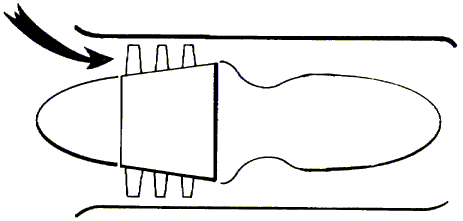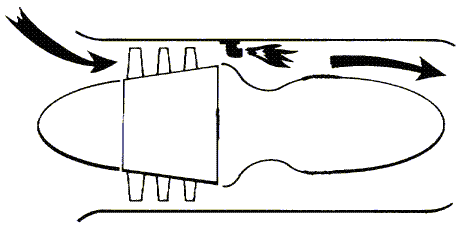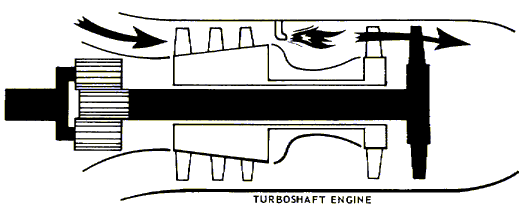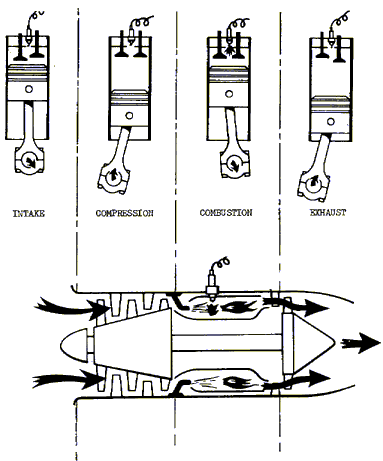Airplane Ground Schools
Knowledge of Flying is Our passion.
Serving the General Aviation Community

If the balloon were converted into a length of pipe, and at the forward end an air compressor designed with blades somewhat like a fan were installed, this could provide a means to replenish the air supply within the balloon.

A source of power is now required to turn the compressor. To extend the volume of air, fuel and ignition are introduced and combustion takes place. This greatly expands the volume of gas available.

![]()
In the path of the now rapidly expanding gases, another fan or turbine can be placed. As the gases pass through the blades of the turbine, they cause it to rotate at high speed. By connecting the turbine to the compressor, we have a mechanical means to rotate the compressor to replenish the air supply. The gases still possessing energy are discharged to the atmosphere through a nozzle that accelerates the gas stream. The reaction is thrust or movement of the tube away from the escaping gas stream. We now have a simple turbojet engine.

The turbojet engine is a high-speed, high-altitude powerplant. The Army, at present, has no requirement for this type of engine. Because it is simple and easy to operate and maintain, however, the Army does use the gas turbine engine. The simple turbojet engine has primarily one rotating unit, the compressor/turbine assembly. The turbine extracts from the gas stream the energy necessary to rotate the compressor. This furnishes the pressurized air to maintain the engine cycle. Burning the fuel-air mixture provides the stream of hot expanding gas from which approximately 60 percent of the energy is extracted to maintain the engine cycle. Of the total energy development, approximately 40 percent is available to develop useful thrust directly.
If we had ten automobile engines that would equal the total shaft horsepower of a turbine engine, it would take six of these engines to turn the compressor, and the other four would supply the power to propel the aircraft. The amount of energy required to rotate the compressor may at first seem too large; however, it should be remembered that the compressor is accelerating a heavy mass (weight) of air towards the rear of the engine. In order to produce the gas stream, it was necessary to deliver compressed air by a mechanical means to a burner zone. The compressor, being the first rotating unit, is referred to as the N1 system.
With a requirement for an engine that delivers rotational shaft power, the next step is to harness the remaining gas stream energy with another turbine (free turbine). By connecting the turbine to a shaft, rotational power can be delivered to drive an aircraft propeller, a helicopter rotor system, a generator, a tank, an air cushion vehicle (ACV), or whatever is needed. The power shaft can extend from the front, back, or from an external gearbox. All of these locations are in use on various types of Army engines at present.
The following sketch shows a turboshaft engine with the power shaft extended out the front. The bottom sketch shows the same engine with the power shaft extending out the back.
The basic portion of the turbine engine, the gas producer, extracts approximately 60 percent of the gas stream energy (temperature/pressure) to sustain the engine cycle. To develop rotational shaft power, the remaining gas stream energy must drive another turbine. In Army engines today, a power turbine that is free and independent of the gas producer system accomplishes this task. The power turbine and shaft (N2 system) are not mechanically connected to the gas producer (N1 system). It is a free turbine. The gas stream passing across the turbines is the only link between these two systems. The free-turbine engine can operate over wide power ranges with a constant output-shaft speed.

In operation, the gas producer (N1) system automatically varies its speed, thereby controlling the intensity of the gas stream in relation to the load applied to the power (N2) shaft. This is accomplished by a fuel metering system that senses engine requirements. The free turbine design has revolutionized the methods of application of shaft turbine engines. Why a shaft turbine? Why is a perfectly good jet engine used to drive a propeller? Because in the speed range that Army aircraft operate, the propeller or helicopter rotor is more efficient. With a turbojet engine, power (thrust) produced is roughly the difference between the velocity of the air entering the engine and the velocity of the air exiting from the engine. Efficiency of the engine (power producer versus fuel consumed) increases with speed until it is 100 percent efficient when the forward speed of the engine is equal to the rearward speed of the jet. It is this low efficiency at takeoff and at low cruising speed (i.e., 400 mph) that makes the turbojet engine unsuitable for use in Army aircraft. The propeller does not lack efficiency at low speed; the reverse is true, in that efficiency falls off at high speed. The result is to harness the jet engine's gas stream energy to drive a propeller or helicopter rotor system, thereby taking advantage of the best features of both.
Aircraft reciprocating engines operate on the four-stroke, five-event principle. Four strokes of the piston, two up and two down, are required to provide one power impulse to the crankshaft. Five events take place during these four strokes: the intake, compression, ignition, power, and exhaust events. These events must take place in the cylinder in the sequence given for the engine to operate.


Although the gas turbine engine differs radically in construction from the conventional four-stroke, five-event cycle reciprocating engine, both involve the same basic principle of operation. In the piston (reciprocating) engine, the functions of intake, compression, ignition, combustion, and exhaust all take place in the same cylinder and, therefore, each must completely occupy the chamber during its respective part of the combustion cycle. In the gas turbine engine, a separate section is devoted to each function, and all functions are performed at the same time without interruption.